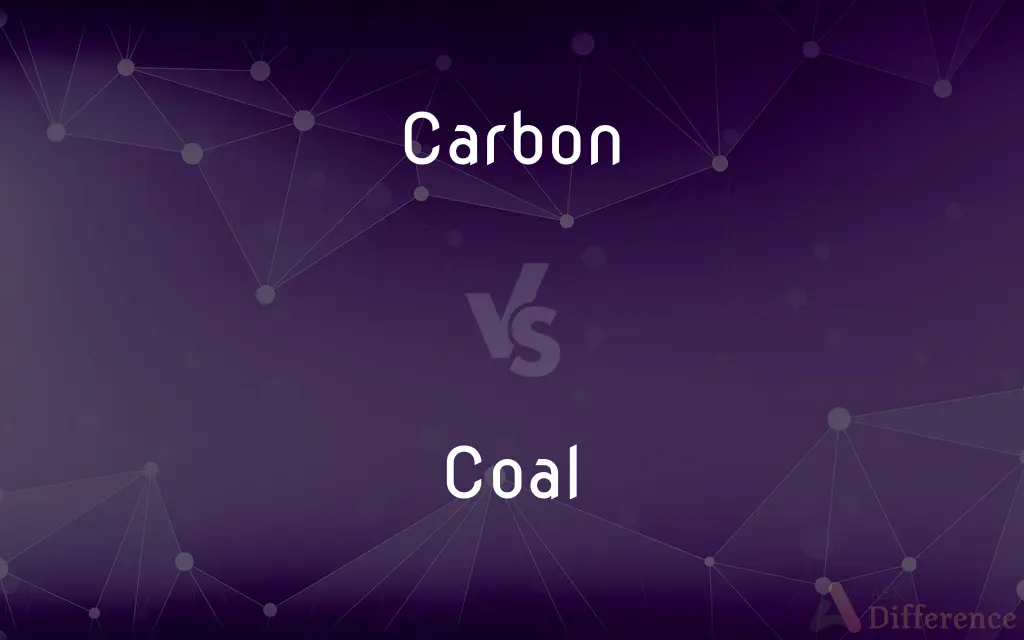Carbon vs. Coal — What's the Difference?
Edited by Tayyaba Rehman — By Urooj Arif — Updated on March 15, 2024
Carbon is a fundamental chemical element, key to life and various compounds, while coal is a combustible black or brownish-black sedimentary rock formed from carbon-rich plant material.

Difference Between Carbon and Coal
Table of Contents
ADVERTISEMENT
Key Differences
Carbon is a versatile chemical element represented by the symbol C on the periodic table, existing in multiple forms including graphite, diamond, and as part of countless organic and inorganic compounds. It is the basis of all known life on Earth, integral to the structure of DNA and other key molecules. Whereas coal is a specific substance composed primarily of carbon, along with varying amounts of other elements such as hydrogen, sulfur, oxygen, and nitrogen. It is a fossil fuel, formed over millions of years from the remains of dead plants and animals, used primarily for electricity generation and steel production.
Carbon, in its pure form, can exist as diamond, which is the hardest natural material, or as graphite, which is soft and used in pencils. This demonstrates carbon's ability to form a vast range of materials with different properties. Coal, on the other hand, is a complex mixture of compounds and does not have such a wide range of physical properties. It is mostly used in its bulk form as a fuel or as a source of carbon for industrial processes.
The environmental impact of carbon and coal differs significantly. Carbon, in its various forms, is a natural part of the carbon cycle, essential for life processes and ecosystems. However, when coal is burned for energy, it releases significant amounts of carbon dioxide (CO2) into the atmosphere, contributing to climate change and air pollution. This highlights coal's role in environmental challenges, whereas carbon, more broadly, is neutral or beneficial within natural cycles.
The economic importance of carbon and coal also varies. Carbon, in its many forms, is crucial for various industries, including pharmaceuticals, plastics, and metallurgy. Its versatile nature allows for a wide range of applications beyond energy, such as in the production of carbon fiber materials. Coal's economic significance lies in its role as a major energy source, particularly in developing countries, and as a raw material in steel production. However, its importance is declining in some regions due to environmental concerns and the rise of alternative energy sources.
The process of extracting and using carbon and coal involves different considerations. Carbon, in forms like carbon dioxide, can be captured from the atmosphere or industrial processes to mitigate climate change impacts. Coal mining, however, has been associated with environmental degradation, including habitat destruction and water pollution. The extraction and combustion of coal pose significant environmental and health risks, underscoring the need for cleaner alternatives.
ADVERTISEMENT
Comparison Chart
Nature
Chemical element (C)
Sedimentary rock composed mainly of carbon
Forms
Exists as diamond, graphite, and in compounds
Mostly found as bituminous, anthracite, etc.
Environmental Impact
Essential for life, part of the carbon cycle
Releases CO2 when burned, contributing to climate change
Economic Importance
Vital for numerous industries beyond energy
Primarily used for energy and steel production
Extraction/Use
Captured for industrial uses, part of natural cycles
Mined, with significant environmental impact
Compare with Definitions
Carbon
A chemical element with symbol C and atomic number 6, known for its ability to form a vast number of compounds.
Carbon compounds are essential to life on Earth.
Coal
A major source of energy and a contributor to global carbon dioxide emissions.
Reducing coal consumption is crucial for fighting climate change.
Carbon
A common element in the Earth's crust and in the atmosphere as carbon dioxide.
Trees absorb carbon dioxide from the atmosphere.
Coal
Consists mainly of carbon, along with variable quantities of other elements.
The quality of coal depends on its carbon content.
Carbon
A non-metal that can exist in different allotropes, including diamond and graphite.
Diamond is a form of carbon known for its extreme hardness.
Coal
Classified by degrees of hardness and heat content, such as anthracite and bituminous.
Anthracite coal burns cleaner and hotter than bituminous coal.
Carbon
The basis of organic chemistry and a key component of fossil fuels.
Scientists study carbon to understand climate change better.
Coal
Mined from the Earth and used in various industries, including steel production.
Coal mining has a significant environmental impact on ecosystems.
Carbon
Essential for the carbon cycle, which supports terrestrial life.
The carbon cycle involves the exchange of carbon between the Earth's biosphere, pedosphere, geosphere, hydrosphere, and atmosphere.
Coal
A combustible black or brownish-black sedimentary rock formed from plant matter.
Coal is primarily used for generating electricity.
Carbon
Carbon (from Latin: carbo "coal") is a chemical element with the symbol C and atomic number 6. It is nonmetallic and tetravalent—making four electrons available to form covalent chemical bonds.
Coal
Coal is a combustible black or brownish-black sedimentary rock, formed as rock strata called coal seams. Coal is mostly carbon with variable amounts of other elements, chiefly hydrogen, sulfur, oxygen, and nitrogen.
Carbon
The chemical element of atomic number 6, a non-metal which has two main forms (diamond and graphite) and which also occurs in impure form in charcoal, soot, and coal.
Coal
A combustible black or dark brown rock consisting chiefly of carbonized plant matter, found mainly in underground seams and used as fuel
A coal fire
Two bags of coal
Carbon
Carbon dioxide or other gaseous carbon compounds released into the atmosphere, associated with climate change
Fossil fuel consumption and carbon emissions continued to rise
The level of carbon in the atmosphere has been consistently rising
Coal
Provide with a supply of coal
Ships had to be coaled and supplied
Carbon
Symbol C An abundant nonmetallic element that occurs in many inorganic and in all organic compounds, exists freely in amorphous, graphite, and diamond forms and as a constituent of coal, limestone, and petroleum, and is capable of chemical self-bonding to form an enormous number of chemically, biologically, and commercially important molecules. Other significant allotropes include fullerenes and nanotubes. Atomic number 6; atomic weight 12.011; sublimation point 3,825°C; triple point 4,489°C; specific gravity of amorphous carbon 1.8 to 2.1, of diamond 3.15 to 3.53, of graphite 1.9 to 2.3; valence 2, 3, 4. See Periodic Table.
Coal
A natural dark brown to black graphitelike material used as a fuel, formed from fossilized plants and consisting of amorphous carbon with various organic and some inorganic compounds.
Carbon
A carbon-containing gas, notably carbon dioxide, or a collection of such gases, especially when considered as a contributor to the greenhouse effect
Plans for capturing and sequestering carbon produced by power plants.
Coal
A piece of this substance.
Carbon
A sheet of carbon paper.
Coal
A glowing or charred piece of solid fuel.
Carbon
A carbon copy.
Coal
Charcoal.
Carbon
Either of two rods through which current flows to form an arc, as in lighting or welding.
Coal
To burn (a combustible solid) to a charcoal residue.
Carbon
A carbonaceous electrode in an electric cell.
Coal
To provide with coal.
Carbon
(uncountable) The chemical element (symbol C) with an atomic number of 6. It can be found in pure form for example as graphite, a black, shiny and very soft material, or diamond, a colourless, transparent, crystalline solid and the hardest known material. Category:en:Carbon
Coal
To take on coal.
Carbon
(countable) An atom of this element, in reference to a molecule containing it.
A methane molecule is made up of a single carbon with four hydrogens.
Coal
(uncountable) A black or brownish black rock formed from prehistoric plant remains, composed largely of carbon and burned as a fuel.
The coal in this region was prized by ironmasters in centuries past, who mined it in the spots where the drainage methods of the day permitted.
Carbon
A sheet of carbon paper.
Coal
(countable) A type of coal, such as bituminous, anthracite, or lignite, and grades and varieties thereof, as a fuel commodity ready to buy and burn.
Put some coal on the fire.
Order some coal from the coalyard.
Carbon
A carbon copy.
Coal
(countable) A piece of coal used for burning this use is less common in American English
Put some coals on the fire.
Carbon
A fossil fuel that is made of impure carbon such as coal or charcoal.
Coal
(countable) A glowing or charred piece of coal, wood, or other solid fuel.
Just as the camp-fire died down to just coals, with no flames to burn the marshmallows, someone dumped a whole load of wood on, so I gave up and went to bed.
Carbon
Carbon dioxide, in the context of climate change. Category:en:Climate change
Carbon neutral
Coal
Charcoal.
Carbon
A carbon rod or pencil used in an arc lamp.
Coal
(intransitive) To take on a supply of coal (usually of steam ships).
Carbon
A plate or piece of carbon used as one of the elements of a voltaic battery.
Coal
(transitive) To supply with coal.
To coal a steamer
Carbon
(informal) carbon fiber.
Carbon bike frame
Coal
(intransitive) To be converted to charcoal.
Carbon
To cause (someone) to receive a carbon copy of an email message.
When I send it, I'll carbon Julia so she's aware.
Coal
(transitive) To burn to charcoal; to char.
Carbon
An elementary substance, not metallic in its nature, which is present in all organic compounds. Atomic weight 11.97. Symbol C. it is combustible, and forms the base of lampblack and charcoal, and enters largely into mineral coals. In its pure crystallized state it constitutes the diamond, the hardest of known substances, occuring in monometric crystals like the octahedron, etc. Another modification is graphite, or blacklead, and in this it is soft, and occurs in hexagonal prisms or tables. When united with oxygen it forms carbon dioxide, commonly called carbonic acid, or carbonic oxide, according to the proportions of the oxygen; when united with hydrogen, it forms various compounds called hydrocarbons. Compare Diamond, and Graphite.
Coal
(transitive) To mark or delineate with charcoal.
Carbon
A carbon rod or pencil used in an arc lamp; also, a plate or piece of carbon used as one of the elements of a voltaic battery.
Coal
A thoroughly charred, and extinguished or still ignited, fragment from wood or other combustible substance; charcoal.
Carbon
A sheet of carbon paper.
Coal
A black, or brownish black, solid, combustible substance, dug from beds or veins in the earth to be used for fuel, and consisting, like charcoal, mainly of carbon, but more compact, and often affording, when heated, a large amount of volatile matter.
Carbon
A carbon copy.
The formation of the compounds of carbon is not dependent upon the life process.
Coal
To burn to charcoal; to char.
Charcoal of roots, coaled into great pieces.
Carbon
An abundant nonmetallic tetravalent element occurring in three allotropic forms: amorphous carbon and graphite and diamond; occurs in all organic compounds
Coal
To mark or delineate with charcoal.
Carbon
A thin paper coated on one side with a dark waxy substance (often containing carbon); used to transfer characters from the original to an under sheet of paper
Coal
To supply with coal; as, to coal a steamer.
Carbon
A copy made with carbon paper
Coal
To take in coal; as, the steamer coaled at Southampton.
Coal
Fossil fuel consisting of carbonized vegetable matter deposited in the Carboniferous period
Coal
A hot glowing or smouldering fragment of wood or coal left from a fire
Coal
Burn to charcoal;
Without a drenching rain, the forest fire will char everything
Coal
Supply with coal
Coal
Take in coal;
The big ship coaled
Common Curiosities
Can carbon exist in forms other than coal?
Yes, carbon exists in many forms, including diamond, graphite, and as part of numerous organic and inorganic compounds.
What is the primary difference between carbon and coal?
Carbon is a chemical element essential to life and found in many forms, whereas coal is a fossil fuel composed mainly of carbon.
Why is coal considered an environmental concern?
Coal is an environmental concern due to its significant contribution to carbon dioxide emissions, air pollution, and the environmental damage caused by coal mining.
What role does carbon play in the Earth's ecosystems?
Carbon plays a crucial role in the Earth's ecosystems, being a key element in the carbon cycle which supports terrestrial life.
How does the combustion of coal affect air quality?
The combustion of coal releases pollutants, including sulfur dioxide, nitrogen oxides, and particulates, which can significantly affect air quality.
How does coal mining affect local communities?
Coal mining can affect local communities through environmental degradation, health impacts due to air and water pollution, and economic dependencies.
How does coal contribute to climate change?
Coal contributes to climate change primarily through the release of carbon dioxide when it is burned for energy.
What are some uses of carbon beyond energy production?
Carbon is used in various industries, including pharmaceuticals, plastics, metal production, and in the manufacture of carbon fiber materials.
How are coal and carbon extracted or captured?
Coal is extracted through mining, while carbon can be captured from the atmosphere or industrial processes to mitigate climate change.
What is the economic significance of coal?
Coal's economic significance lies in its use as a major source of energy and as a raw material in steel production.
What initiatives are in place to reduce coal consumption?
Initiatives to reduce coal consumption include investments in renewable energy, carbon pricing mechanisms, and policies aimed at phasing out coal-fired power plants.
Are there environmentally friendly alternatives to coal?
Yes, environmentally friendly alternatives to coal include renewable energy sources like solar, wind, and hydroelectric power.
What are the challenges associated with transitioning from coal to cleaner energy sources?
Challenges include the economic costs, infrastructure changes needed, and ensuring energy security and reliability during the transition.
Can carbon capture technology reduce the impact of coal usage?
Carbon capture technology can reduce the impact of coal usage by capturing carbon dioxide emissions from coal-fired power plants and storing them underground.
What are the prospects for coal in a future energy mix?
The prospects for coal in a future energy mix are declining due to environmental concerns, the rise of renewable energy sources, and global efforts to reduce carbon emissions.
Share Your Discovery

Previous Comparison
Frankfurt vs. Saveloy
Next Comparison
Lassie vs. LadAuthor Spotlight
Written by
Urooj ArifUrooj is a skilled content writer at Ask Difference, known for her exceptional ability to simplify complex topics into engaging and informative content. With a passion for research and a flair for clear, concise writing, she consistently delivers articles that resonate with our diverse audience.
Edited by
Tayyaba RehmanTayyaba Rehman is a distinguished writer, currently serving as a primary contributor to askdifference.com. As a researcher in semantics and etymology, Tayyaba's passion for the complexity of languages and their distinctions has found a perfect home on the platform. Tayyaba delves into the intricacies of language, distinguishing between commonly confused words and phrases, thereby providing clarity for readers worldwide.














































